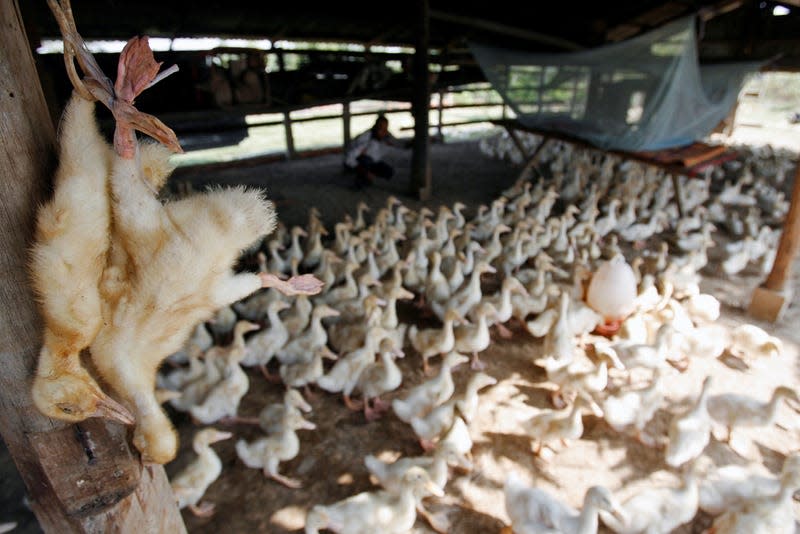The full genome sequencing of Cambodia's bird flu strain took less than a day

Avian flu — or H5N1 — is a deadly disease, although not one that typically affects humans.
It’s been going around globally for decades, but there have been no cases of human-to-human transmission. Human cases instead typically result from interactions with sick birds. When it does infect humans, the mortality rate is more than 50%—on par with ebola and about 16 times higher than covid.
Read more
That’s why recent outbreaks, especially involving mammals like us, have been cause for concern in a world suffering from post pandemic stress. Since the beginning of the year, health officials have recorded several worrying episodes. In Peru, more than 700 sea lions died of avian flu, which they likely contracted through their contact with pelicans, thousands of which also died from the disease.
At a mink farm in Spain, the virus spread throughout the farm’s densely packed mammal population (the whole farm contained more than 50,000 mink). Tests done on the virus that infected the minks found that it had acquired at least one mutation that makes it more transmissible between mammals—the most alarming sign yet that it could cause outbreaks among humans.
Then, on Feb. 23, the virus killed a young girl in Cambodia. Her father tested positive, but developed no symptoms. The global health community rushed to identify the strain of the virus, and was able to do so in record time.
The importance of quickly identifying the virus strain
In the context of the ongoing, multiple, global outbreaks of avian flu, the World Health Organization (WHO) labeled the Cambodia case as “worrying.” Bird flu isn’t new to the country: According to the WHO, since 2013, a total of 58 cases have been reported in Cambodia, resulting in 38 deaths. Yet the concern was that the virus in Cambodia was not of the strain endemic to the region, but the one that has been causing the recent outbreaks in Europe and the Americas. That strain—the same that mutated to spread from mink to mink—is present in Asia, too.
It took a team of scientists led by Erik Karlsson—a virologist now directing the Institute Pasteur du Camboge, Cambodia’s branch of the international French nonprofit that researches diseases and vaccines—less than 24 hours to go from testing and isolating the virus, to fully sequencing it. It was the endemic strain.
“There’s been this sense that people had this relief when we released the data,” Karlsson said. “In the scientific community, there was a sense of understanding: Okay, this virus has been endemic in Southeast Asia for 10 plus years.”
The strain of virus identified, Karlsson said, has been circulating since 2013, and researchers are familiar with its characteristics. “There’s still chances every time it gets into a human or a mammal, that it could mutate or become a strain that that could transmit between people to people,” he says, which is why monitoring and sequencing is so important—the faster the better.
“The cost of any kind of outbreak gets exponential by the second that you don’t respond to it,” he said.
Faster, better, cheaper sequencing technology
The speed at which Karlsson’s team sequenced the virus in Cambodia illustrates the lasting impact of investments in surveillance and genomic sequencing made during the pandemic, including in parts of the world that previously struggled to access the most advanced technologies.
“Now instead of having to spend $150,000 on a sequencer, we can spend $1,000, and with that sequencer we can sequence the full genome of an influenza virus for $100 within 24 hour,” Karlsson said.
The results of the sequencing have been shared with the broader scientific community, which can access them easily, for instance through the real-time tracking hosted by Louise Moncla, a University of Pennsylvania professor of pathobiology. This is the type of scientific collaboration that led to the development of the covid vaccine, though Karlsson underlines that it is in no way a new approach, just one that, after covid, is all the more recognized as essential.
“It takes a village. You need people in the field to go do interviews. You need people to take samples, need people in the laboratory to analyze the samples. You need people that are developing these databases for sharing, and you need global infrastructure systems to then share these viruses,” he said.
Beyond the surveillance aspect, the sequencing is essential to make rapidly available vaccine candidates, as happened with covid, or every year with the seasonal flu. There are vaccine candidates for all the kinds of avian flu identified so far, so it would be relatively easy to make doses of the actual vaccine if needed. The US also has a stockpile of avian flu vaccines produced by Australian biotech company CSL Sequirus. Several countries have also long pushed for the UN to have its own stockpile of avian flu vaccine.
More from Quartz
What higher H-1B fees will mean for Indians hoping to work in the US
More than half of US nursing homes are unprofitable—and it's about to get a lot worse
Sign up for Quartz's Newsletter. For the latest news, Facebook, Twitter and Instagram.
